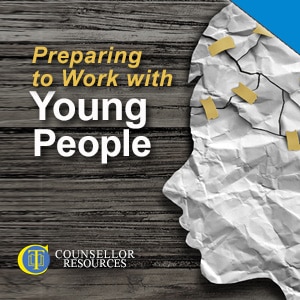Child and Adolescent Counselling Training - CPD
Importance of Personal Therapy
Working with young people is very different from working with adults. While having your own therapy is important regardless of client group, it’s even more so if you’re thinking of working with children.
Think about why you are drawn to work with children – for example, if you had a difficult childhood yourself and want to offer children experiencing the same problems, it’s important to consider projective identification (a phenomenon in which an individual projects part of their self onto another).

We have to be careful that when we’re working with children, we don’t project our childhood angst, fears and unresolved issues onto them.
One of the things that you need to have as a young person’s therapist is resilience, because sometimes young people can act out, projecting onto you: you need to be grounded. Children can be very direct in their communication style.
Watch this Lecture + Access Hundreds of Hours of CPD
Certified CPD for Qualified Counsellors
- Hundreds of hours of on-demand CPD lectures to help you stay current with your CPD ethical requirements
- Support, and be supported, by thousands of other counsellors as a member of the exclusive online community.
- Access your learning anytime you want ... anywhere you choose ... using any device type — desktop or mobile.

Attachment Style
It’s also important to understand our own patterns of attachment and loss. Being aware of our attachment patterns can help us avoid over-identification with the client.
It’s very possible that if we have an anxious attachment style, we may over-identify and become over-connected to the client.
This is a particular problem when working with children as we are likely to hear very difficult and sad stories of their lives, especially as children may be less inhibited than adults in what they tell us.
We must not be drawn into rescuing the client: maintaining professional boundaries is vital, both for the client and for our own well-being.
It could also happen that your and the client’s respective attachment styles clash.
For example, if you’re working with a young person whose attachment style is dismissive-avoidant (‘I’m OK; you’re not OK’), this could clash with your own attachment style, making you think they’re not investing any effort in therapy.
We must not be drawn into rescuing the client: maintaining professional boundaries is vital, both for the client and for our own well-being.
Transference
Transference could occur if, for example, something in the school environment triggers your memory of your own school days – perhaps making you fear being rejected.
Again, personal therapy may be important in understanding and working with this.
Attitude to Parents
Another thing to consider is the importance of not undermining clients’ parents. Your own parenting style (if you have children) may be completely different from theirs.
While you need to listen to what the child said and work with the emotions, don’t undermine their parents’ approach unless there’s a definite issue of harm (in which case, that’s not undermining parenting – it’s child protection).
On a related note, don’t try to be the client’s parent: they need someone to listen to them, not to act as another parent.
In particular, be wary of children or young people saying to you, ‘I wish you were my mum/dad’ – because that suggests they’re seeing you not as a therapist but as a substitute parent.
This can lead to many difficulties, including in how they invest in the therapy and in ending.
Understanding Child Development
Because it’s vital to work to the developmental age of the client, you must have a good understanding of child development. This will enable you to differentiate between the client’s own words and those they are repeating based on what they’ve heard adults around them say.
Don’t try to be the client’s parent: they need someone to listen to them, not to act as another parent.
It also helps you tailor the length and structure of the session to their needs.
A good rule of thumb in teaching is that a young person’s attention span is about half their chronological age. So, for example, if you’re working with someone who’s 15, they’ve typically got an attention span of 7.5 minutes.
Free Handout Download
Working with Children and Young People
Creativity
In child therapy, we need to learn to be creative and to work in a way that children can understand and engage with.
Colouring books, paints, pencils, felt-tip pens, paper and modelling materials are found in the toolbox of most child and adolescent therapists, and can all help hold young people’s attention.
Language
When you do use language, this needs to be really clear. For example, if talking about loss and bereavement, don’t use phrases such as ‘crossing over’ or ‘going to heaven’.
Language must be age-appropriate to the client, so they can understand it easily.
If a child is discussing issues of a sexual nature and using adult language, don’t assume that they understand what the words mean.
Be very careful to work with their own meanings, but don’t be tempted to explain sexual issues they don’t know or understand. Y
ou may be working beyond their emotional and developmental age, and it’s also what people who groom children do.
Applicability of Skills and Theories
Some counselling skills and theories don’t work particularly well with children, having not been developed for this client group; they often need to be diluted and modified to fit childhood experience.
For example, young people tend to find silence particularly uncomfortable.
Young people sometimes ask for advice. You can work around this in person-centred counselling by asking: ‘What choices have you got?’ or ‘If you were advising a friend, what would you say?’
In this way, you encourage them to identify, weigh up and make their own choices.
If you’re practising CBT, you may well find one of the challenges to be that your young client won’t complete and bring back worksheets that you set them as homework.
Training
It follows that specialist training is essential if you wish to work with children.
For example, you need to know how to use creative methods, and have a really good understanding of many laws and policies/procedures that aren’t typically covered in standard courses.
You also need an understanding of child development – e.g. Piaget’s theory of cognitive development and Freud’s theory of psychosexual development – and of childhood attachment patterns.
Legal Aspects
You may have your notes requested by the police or the Crown Prosecution Service.
If this does happen, it’s important to ask the client if they want them released, and to explain what might happen if they do agree. You may have to appear in court yourself.
In England, you have to be thoughtful about working with clients who have difficulties or issues around adoption.
In 2010, the law changed so that – to work with either a child or an adult around their adoption – you must be a registered adoption therapist with Ofsted.
You may be asked to write a report for court or for social workers.
If you’re working with a child in care or looked-after child, you’d almost certainly have to speak with the social worker. You may even have to attend multidisciplinary meetings or write a report if you can’t do so.
Gillick Competence
Gillick guidelines ask the therapist to consider whether clients under the age of 16 have sufficient understanding to make an informed decision about undertaking therapy.
If the client has Gillick competence, they have the right to make decisions without parental consent and be granted confidentiality.
Learning disabilities, drug/alcohol use or mental health issues may affect whether a young person really understands what therapy is.
While there’s no official minimum age for Gillick competence, most practitioners would consider that children under 13 do not have the cognitive development to fully understand the nature of the process of counselling.
Contracting and Confidentiality
You might have to meet your clients’ parents – although you’re not their therapist, tact, discretion and confidentiality are still imperative.
It’s usual to have a triangulation contract between the young person, parent and therapist – though there may be times when you’re working with young people whose parents don’t know they are having therapy.
If you do have a triangulation contract, any meeting must be with the agreement of your client unless there is a very good, ethically justifiable reason why not; it must also have objectives.
Such meetings can be very productive. Do make sure you write thorough notes afterwards, recording what was covered and agreed.
If you’re working in a school as part of a multidisciplinary team, it’s important that you acquaint yourself with its child-protection policies and procedures.
The Caldicott principles are relevant here, with respect to information-sharing. It’s also vital to be aware of the referral pathways you have access to.
When Counselling is Involuntary
You may be asked to see children who are being sent for therapy – perhaps by teachers because of poor attendance or disruptive behaviour in class, or by parents because of concerns about self-harm or substance misuse.
Do remember that therapists are not agents of social control. It can be useful to be seen as slightly separate from the school.
It is helpful to ask the young person whether they want to be in therapy (if not, no amount of therapy is going to help), to explain what therapy is and is not is, and to contract for a taster session.
It’s good to empower them in this way, and important always to respect their wishes where possible.
Working with Term Dates
Unsatisfactory endings may feature frequently in work with this client group – often because studies take priority over therapy, or simply because they forget to come.
Also, you are restricted to term-times – so you have to consider whether ethically it’s appropriate to start working with a new client shortly before a school holiday starts.
Choosing a Supervisor
The importance of having a supervisor who has experience in counselling young people cannot be underestimated – so that you can discuss topics such as developmental age, and the law relating to children’s therapy.
You could also consider group supervision with other therapists who work with children, sharing experience and knowledge.
Free Handout Download
Working with Children and Young People